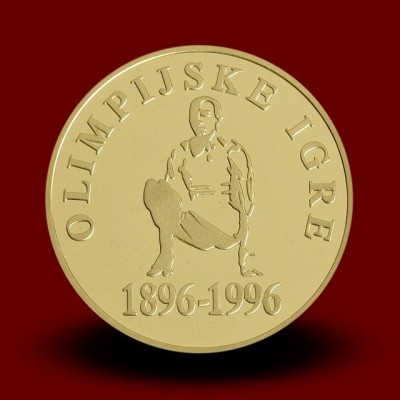Ni izdelkov
z DDV
Izdelek uspešno dodan v košarico
Število izdelkov v košarici: 0 V košarici imate 1 izdelek.
| Masa | 7 g | ||
| Čistina | 900 / 1000 | ||
| Vsebnost zlata | 6,3 g |
||
| Mera kovanca (premer) | 24 mm |
||
| Nominala | 5000 tolarjev |
||
| Leto kovanja | 1996 | ||
| Naklada | 1.000 kovancev | ||
Vir: Banka Slovenije
Človek se že od nekdaj ukvarja s športom. Ta mu pomeni krepitev njegovih telesnih moči, da bi lažje sledil hitremu tempu sodobnega načina življenja. Že od nekdaj pa je v ljudeh tudi tekmovalni duh, ki jih sili, da na najrazličnejše načine preizkušajo svoje moči. V davni antiki so se športniki merili med seboj v raznih veščinah in tekmovali, kdo bo hitrejši, kdo bo dlje skočil in kdo bo najmočnejši.
Pierre de Couberten, ki velja za velikega ideologa in stratega olimpijske miselnosti, je leta 1894 uspel obnoviti nekdanje olimpijske igre po antičnem vzorcu in že dve leti kasneje so bile v Atenah prve olimpijske igre moderne dobe. Olimpijski ogenj je spet združeval tekmece z vsega sveta pod skupno zastavo s petimi krogi, ki simbolizirajo olimpijsko geslo citius, altius, fortius.
Slovenci smo že zelo zgodaj sodelovali na olimpiadah. Lahko se pohvalimo z uspehi naših telovadcev, smučarjev in veslačev. Zlate, srebrne in bronaste kolajne krasijo njihove vitrine. Med vsemi je gotovo najpomembnejši starosta olimpijcev vsega sveta telovadec Leon Štukelj, ki je prva priznanja dobil že daljnega leta 1924. Zato ni naključje, da je ena njegovih značilnih drž pri telovadbi (originalna fotografija je bila posneta na olimpiadi v Berlinu leta 1936) uporabljena tudi kot motiv na priložnostnih kovancih.
Ob 100-letnici olimpijskih iger moderne dobe izdaja Republika Slovenije tudi zlate spominske kovance:
- zlatnik z nominalno vrednostjo 5.000 tolarjev, s težo 7 gramov in premerom 24 milimetrov, čistine 900/1000, v količini do največ 3.000 kovancev.
- – -
100 years of Olympic games of modern times (1996)
Man has always engaged in sports. Physical strength, helping to more easily follow the busy tempo of the modern way of life, can be built up in this way. Man has always possessed competitive spirit which made him test his abilities in different ways. In antiquity sportsmen competed in various disciplines in order to find out who was the fastest, who was able to make the longest jump and who was the strongest.
Pierre de Couberten , the great ideologist and strategist of Olympic thought, managed to revive the Olympic Games in 1894 in accordance with the ancient model. Two years later, the first Olympic Games of Modern Times took place in Athens . The Olympic flame again united sportsmen from all over the world beneath a common flag with five circles, symbolising the Olympic slogan CITIUS, ALTIUS, FORTIUS.
The Slovenes have very early participated in the Olympic Games. We can be proud of the success of Slovene fencers, gymnasts, skiers and rowers. Gold, silver and bronze medals decorate their display cabinets. The oldest and one of the most important among former Olympic participants from the whole world is the gymnast Leon Stukelj, who won his first medals as early as in 1924. Therefore it is not a coincidence that one of his characteristic postures at gymnastics (the original photo was taken at the Olympic Games in Berlin ) in 1936 was used as a motif on commemorative coins.
This year 1994 Slovene athletes will travel to Atlanta to attend the Olympic Games. They will set out on this journey not only with the goal to achieve the best possible results, but also to strike up friendships and, with their achievements, spread the name SLOVENIA around, since the Slovenes are also part of the large Olympic family.
To mark the 100th anniversary of the Olympic Games of Modern Times, the Republic of Slovenia hereby issues also gold commemorative coins:
- a gold coin with a nominal value of 5.000 tolars, a weight of 7 grams, a diameter of 24 mm and a purity of 900/1000, in a quantity of maximum 3.000 coins.
Authors of the idea for the design: Gorazd Vahen and Gojko Zrimsek, Ljubljana
Minting: State Mint, Kremnica/Slovakia
| Čistina | 900/1000 |
| Prevzem | * |
| Davek | Naložbeno fizično zlato je oproščeno plačila DDV po 118. in 119. členu ZDDV-1. |



